Read More»
About SepakTakraw The Acrobatic Sports
Wednesday 7 April 2010

Where to see Sepaktakraw in Medan
Posted by Admin | No comments
Recreational sepak takraw can be seen played in the Lapangan Merdeka (city's public parks)
Played every Sunday morning,
from about 7:00 until 10:30.
Location:
Kereta Api Road, front of the central post office.
Contact:
+ 62 81263007336 - Mr. Zulfan Tachir Harahap
+ 626177496594 - Mr. Chairullah
+ 6281396280999 - Mr. Husni
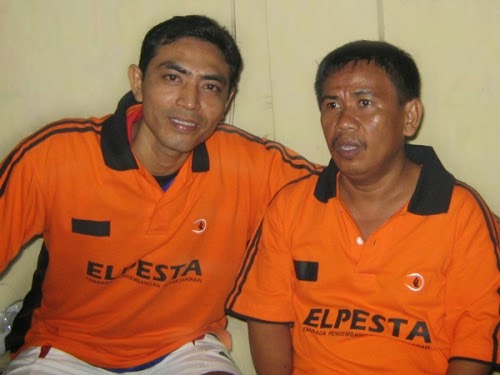
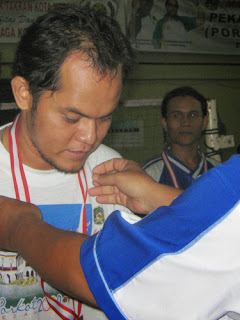
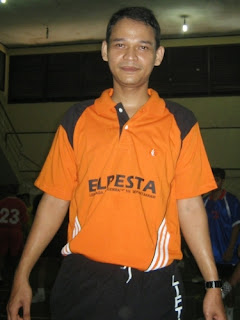

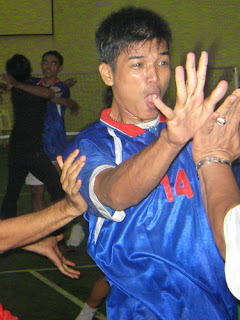


Read More»
Played every Sunday morning,
from about 7:00 until 10:30.
Location:
Kereta Api Road, front of the central post office.
Contact:
+ 62 81263007336 - Mr. Zulfan Tachir Harahap
+ 626177496594 - Mr. Chairullah
+ 6281396280999 - Mr. Husni







SEPAKTAKRAW IS AN AMAZING SPORT
Posted by Admin | No comments
by: Kevin Ross
Sepak takraw is an amazing sport. The athletes are in incredible shape and can do the most amazing feats. This gentleman is about to kick the ball over the net while flipping in the air. I've never seen anything like it until today. I had to take pictures to share with TL friends. This sport should have ESPN coverage, it's just unbelievable what these guys can do. As for the game it's like volleyball only you use your feet and head to move the ball over the net.
I used a high shutter speed of 1/320 to capture the movement. The foot is still a little blurred but he was moving so fast. Not much done in PP just cropped, added frame then resized for TL.
One added note, I know the ball is cut off a little I tried to time it just right. Again this is a fast game and it's difficult to get the timing down.
Thanks for viewing and I hope you like it.
(http://www.treklens.com/gallery/North_America/United_States/photo416043.htm)
Read More»
Sepak takraw is an amazing sport. The athletes are in incredible shape and can do the most amazing feats. This gentleman is about to kick the ball over the net while flipping in the air. I've never seen anything like it until today. I had to take pictures to share with TL friends. This sport should have ESPN coverage, it's just unbelievable what these guys can do. As for the game it's like volleyball only you use your feet and head to move the ball over the net.
I used a high shutter speed of 1/320 to capture the movement. The foot is still a little blurred but he was moving so fast. Not much done in PP just cropped, added frame then resized for TL.
One added note, I know the ball is cut off a little I tried to time it just right. Again this is a fast game and it's difficult to get the timing down.
Thanks for viewing and I hope you like it.
(http://www.treklens.com/gallery/North_America/United_States/photo416043.htm)
Knowing SepakTakraw
Posted by Admin | No comments
The rattan ball is still in common use, but the game has improved on its commercial aspect incorporating badminton, soccer and volleyball rules. Any body part, except the hand and the arms up to the shoulder joints, can legally touch the rattan ball; like volleyball, the ball can be touched by a team three times before passing it over the opponents' court. But unlike volleyball, one person can do all the touching.
It's a fast paced game with the Sepak players looking like a combination of a ballet dancer and a tree frog fearing for his life.
(http://www.sport-games-info.com/archives/96-Knowing-Sepak-Takraw.html)
.......................................................................
Sepak takraw is ... exciting, fantastic, unusual, energetic, acrobatic, is an action
http://takraw.webark.orgWhat is Sepak Takraw ? For you maybe these words mean nothing... but not for long :) Someone told me this sport is "...soccer, volleyball and gymnastics played in one." And in my home opinion the most exciting things about this game are the discoveries of how much you can do with your feet. Oh yes, it's worth being played. This skill ball game, originated in Asia, today has become an alternative sport, which is quite popular all over the world
History in brief.
So the history of this sport movement is as following... I think it's not a surprise for you that every nation has her proud myriad of cultures, arts, literature and traditional sports. It is recorded in the cultures of South-East Asia nations as early as in the 11th century that the game was played extensively - Takraw in Thailand, Sipa in the Philippines, Sepakraga in Malaysia, Singapore and Brunei, Ching Loong in Myanmar, Rago in Indonesia and Kator in Laos. It is also recorded that in one of his many trips, the merchant Marco Polo brought back to Europe a game from China which was kicking an implement into the air and counting the number of kicks, a style resembling today's sepak takraw game.
Sepak takraw is a skill ball game, which requires the use of the feet and head to keep the ball in the air in a targeted direction. Traditionally, villagers stand in a circle and display keen understanding and teamwork to help one another keep the ball in the air for as long as possible. It provided villagers of all ages with fun, recreation and a sense of shared community. This was the traditional circle game, evolved from many forms of kicking game. Today, the circle game is still popular throughout South-East Asia and has taken a hold as a form of recreational "sport for all".
In a new variation introduced by the International Sepaktkaraw Federation in 1996, players stand in a circle and receive different level of points for each passing kick. The circle event was included as a medal event in the 13th Asian Games in Bangkok in 1998. Sepak takraw using the net came about in the 19th century. In 1960, representatives of various South-East Asia nations established a set of rules and regulations for the game and called it sepak takraw. In 1965, th game was included in the South-East Asian penisula Games and since then, has made great strides with its debut as a medal event in the 10th Asian Games in Baijing, China in 1990.
The formation of the International Sepaktakraw Federaion by the Asian Sepaktakraw Federation in 1988 contributed greatly towards a global promotion of the game. Since then many countries outside of Asia have taken up the sport, including the United States, Canada, England, Finland, Germany, Puerto Rico, Colombia, Brazil, Australia and New Zealand.
Outdoors Articles Phone cards Whip Guide song lyrics Love Lyrics phone cards.
.......................................................................
Spectacular, Acrobatic, Fascinating, Fast, Powerfull, Exciting
http://www.takraw.asiaMalaysia's Mohamad Putra tries to block the ball from Thailand's Singha Somsakul (red) during the men's sepak takraw team finals at the Asian Games in Doha December 6, 2006Sepak takraw or Takraw is a sport native to Southeast Asia, resembling volleyball, except that a rattan ball is used and players are only allowed to use their feet, knee, chest and head to play the ball.
It is a very popular sport in Thailand, Cambodia, Malaysia, Laos, Australia, Philippines and Indonesia.
The Asian Sepak Takraw Federation (ASTAF) has proposed the sport to be included in the Olympic Games in 2020 after making a successful debut at the Asian Beach Games.
"With such a success, we are planning to introduce the sport to the Olympic Games in 2020," ASTAF President Abdul Halim was quoted as saying on Friday by the Jakarta Post daily.
"Starting now, of course, we have to promote the sport in order to fulfil the requirement that 75 to 80 countries play sepak takraw," he added.
Halim said that people in 45 countries and regions worldwide now play sepak takraw and ASTAF is urging powerhouses likeThailand, Indonesia, Malaysia and Singapore to help promote the sport.
"It is reasonable that 20 coaches from those countries will be sent to undeveloped sepak takraw countries to support the promotion program," he said.
 |  |
 |  |
 Thailand's Pornchai Kaokaew (in red) strikes the ball as Malaysia's Mohamad Azlan (in yellow) tries to block during their men's sepaktakraw team final match. Thailand's Pornchai Kaokaew (in red) strikes the ball as Malaysia's Mohamad Azlan (in yellow) tries to block during their men's sepaktakraw team final match. |  Pornchai Kaokaew (in red) blocks the ball from Mohamad Azlan during their men's sepaktakraw team final match at the 15th Asian Games in Doha December 6, 2006 Pornchai Kaokaew (in red) blocks the ball from Mohamad Azlan during their men's sepaktakraw team final match at the 15th Asian Games in Doha December 6, 2006 |
The Sport of Sepak Takraw
By: Bob | December 14th, 2006http://www.theoffside.com/asia/the-sport-of-sepak-takraw.html
Lost in the shuffle of all the crazy plays that took place in the semifinals of the Asian Cup football competition this week was the continued dominance of Thailand’s men at the sport of sepak takraw. The Thai men won their 14th Asian Cup gold medal in 22 tries thanks to the stellar play of Suebsak Phunsueb, the man who some say is the best to ever play sepak takraw. If you aren’t familiar with the sport, and chances are you aren’t unless you live in pockets of Asia, it can best be described as a combination of volleyball, badminton and soccer.
From the Bangkok Post:
The sport developed from a game called sepak raga, which was played in the Malay states in the 15th century. That game was played by a group of players who stood in a circle and kept a raga in the air for as long as possible without using their hands.
The earliest recorded instance of a similar game being played dates back to the 11th century.
The name sepaktakraw comes from the Malayan word ’sepak’, which means kick and ‘takraw’, which means woven ball.
The game is played on a field similar to a badminton court and the net is shoulder high, allowing the players spectacular bicycle kicks which would not be amiss in an acrobatic show.
Three players are on the field at any given time (apart from the doubles event, when just two are on the field).
They can use any part of their body to play the ball excepting hands and arms. The game used to be played with a rattan ball, but since 1984, when a Thai inventor introduced a synthetic sepaktakraw ball, it has gained a much wider appeal.
 |  |
Involving a skill set that is familiar to footballers, it sure would be interesting to see how some of the top players in the world would fare at sepak takraw. Here’s a video sample of what the sport looks like in action.
.......................................................................
Sepak Takraw
The game of sepak takraw is relatively easy to master—that is, if you're able to extend your leg well over your head while jumping, block a small ball traveling at 97 km/h (60 mph) with a flying headfirst leap, and perform a full-speed backward cartwheel that is timed to spike the ball into an area the size of a badminton court.These are some of the maneuvers regularly practiced by skilled participants of sepak takraw, which the United States Takraw Association calls “volleyball, gymnastics, and soccer all rolled into one.” ”A game of world-class takraw seems to defy gravity,” according to Sports Illustrated.
Sepak takraw is the organized, competitive version of a game that has roots in several Southeast Asian countries and many variations.
The sport, which originally involved simply kicking around a rolled-up ball of cane, has been around in one form or another for centuries. In 1965 at the South-East Asian Peninsula Games (SEAP, later SEA) it became a multinational competitive sport. That event helped spark interest in a sport whose enthusiasts would like to see it enjoyed by the world at large. “With soccer exploding in popularity in this country and the exhilarating foot fun of takraw, we expect a whole new tribe of takraw enthusiasts to spread across the United States,” said the U.S. Takraw Association in 1997.
Several Southeast Asian countries claim sepak takraw as their own. The game has been played by the indigenous people of what is now Malaysia since the 15th century. Known as sepak raga—sepak is Bahasa Malaysia for “kick”—the game was played in the courts of early Malaysian royalty. “There are many references to it in Malayan folklore,” according to the International Dictionary of Sports and Games. “When Malaya was under British rule the game was partly replaced by rugby, cricket, and other sports. However, it survived in rural surroundings where it was a favorite recreation of the Malay peasants.” The game survived because of its simplicity: All that was required was a woven ball, and the game could be played indoors or out. Its popularity was reinforced because it required many of the skills of soccer, which was also popular in Malaysia and other Southeast Asian countries.
In traditional Malaysian sepak raga, groups of males standing in a circle attempted to keep the ball of rolled rattan cane aloft with their feet and heads. Participants often count the number of hits they are able to make. That version of the game is still played on street corners and in villages in Southeast Asia.
The game was also traditionally played in the Philippines, where it is known as sipak, and in Laos, Singapore, Indonesia, and other countries. It also has roots in Myanmar (formerly known as Burma). Some evidence suggests that in 1889 a Burmese by the name of Maung San Hyin introduced the game, known as shin long in that country, to Thailand. The game took off in Thailand, where it was called takraw, Thai for “woven ball,” and developed into a few variations that are still played.
Hoop takraw is one of the most difficult versions of the sport—and one of the most entertaining to watch. In hoop takraw, which is popular in Thailand, participants stand in a circle and hoops are suspended over the center of the circle. Each player makes a hoop out of his arms behind his back, and then he kicks the ball with his heel so that it goes through his arms and then through the hoops overhead. In another takraw version, participants keep the ball aloft and are judged by the audience for style and the difficulty of their moves.
To make the game more competitive, in 1945 Malaysian players began using a net, called a jaring, and playing the sport with rules similar to those of volleyball. Twenty years later the sport was set to be included in the SEAP Games, and officials from Malaysia, Thailand, Singapore, and Laos convened to adopt regulations for the sport. They adopted the name sepak takraw by combining the Malaysian and Thai names for the sport, and they created the Asian Sepak Takraw Federation.
In the early years of competitive sepak takraw, taller players dominated the sport. But eventually shorter players developed astonishing acrobatic moves, allowing them to spring into the air and spike the ball.
High-level takraw (often known in the West as foot volleyball) is something to watch. Two teams of three players face each other across a net 1.55 m (5 ft 1 in) high. Competitors use their feet, legs, head, and shoulder to volley the ball, which is the size of a grapefruit, back and forth across the net. But that description is a bit like saying that in basketball, Michael Jordan throws a leather ball into an iron hoop. “Top players perform midair somersaults, kicking the ball when their legs are several feet above the net and then magically gyrating and landing upright,” Sports Illustrated said. “Takraw is lightning fast: A well-kicked spike can accelerate the ball to 145 km/h (90 mph); a good serve can reach 97 km/h (60 mph).”
.......................................................................
Game of Catch
By: Anne E. Johnsonhttp://storiesforchildrenmagazine.org/GameofCatch.aspx
There’s nothing like baseball on a summer day, or football and basketball in the winter. People love games, especially with a ball to throw, catch, or hit. You probably know many ball games, but there are many around the world that you may not have heard of.
Ball sports have a long history. Many of the oldest ones were played at festivals honoring gods. Some of those are still played today. Every year, villages in the Himalayan Mountains challenge each other to a game of induara in celebration of the god Mahasu. A team captures a soccer-type ball and they try to hold it on their side of the field. Even the stuffing for the ball is considered sacred.
Over 3,500 years ago in Mexico, the Aztecs played a religious game called ulama. This may be the earliest sport to use a rubber ball. The players hit the small ball with sticks and their arms and hands. The ball court was believed to be a gateway from life to death, or from human to divine. In some Mexican towns, people still enjoy playing ulama, but it’s not a religious game anymore.
Most ball games are just for fun. In Sweden and Germany, kids play Brennball, which means “burn ball.” In Brennball, as in American baseball, a batter from one team faces players on a field. However, there is no pitcher. The batter tosses the ball in the air and smacks it with a bat. He keeps one foot on the batter’s plate and may not hit the ball over his head. Nobody wears a glove, not even the catcher. The batter scores one point for reaching home plate, but six points for a home run. And the team in the field also earns points for getting runners out.
.......................................................................
Sepak Takraw: Volleyball, Kung Fu, Gymnastics and Circus Acrobatics Rolled into One
http://www.associatedcontent.com/article/431949/the_sport_of_sepak_takraw_thailands.html?cat=16Sepak Takraw is one of Southeast Asia's most popular sports, yet most Westerners have never heard of it. Imagine a net like in volleyball, then reduce the volleyball to the size of a grapefruit
and make it out of rattan, and that's all the equipment required for a Sepak Takraw game. But, unlike volleyball where you can use your hands, in Sepak Takraw the players are only allowed to touch the ball with their feet, body or head. This leads to some of the most amazing acrobatics ever seen on a court. In fact, Sepak Takraw is very much like a mix between volleyball, gymnastics, kung fu and circus acrobatics. You've got to see it to believe it!
In Thailand, the game is called just Takraw, and is often played by laborers or motor-cycle taxi drivers at the end of the day, when they want to wind down. They will find an empty piece of land where they will park two trucks or cars. Then they will string up a takraw net between the two vehicles and, voila, the game of takraw can begin. It's also played at temples, in fairgrounds, in schools and in parks all over Thailand. In fact, anywhere where the players can find a spare piece of flat ground.
The game probably originated in China as the kickball game of cuju then, by traders coming down into Thailand from China it was introduced to the Thais as early as the 1400s. You can see the game today in paintings on the walls of several temples in Thailand, where gods such as Hanuman play takraw. These paintings are often more than 250 years old. The sport became incredibly popular in Thailand when, in the early 1800s the Siam Sports Association created the first written rules for takraw. Soon after, it became a popular sport in schools all over the country and remains so today, especially out in the Thai provinces.
Takraw nowadays is played on a court that is similar to a volleyball court, with a net where the top is five feet above the ground. There are two teams, consisting of three players on each team.
To start the game, the inside player of the serving team hits the ball to the server (the Tekong) who serves it over the net with a kick. The game is usually played in two sets with the winning team of the set being the one who reaches 21 points first. If each team wins one set, there is a tiebreaker game that will go up to 15 points unless it ties at 14-14. Then the game will end at 17 points.
Thailand has the world's best takraw players. Malaysia is Thailand's main rival, but Malay players, so far, have not managed to consistently get to the unbelievable game playing of the Thais. However, in countries like Vietnam, Hong Kong, and South Korea, takraw is becoming a popular sport so, in the future, the Thais may have more competition for the title of the world's best players. Even in England, Europe and the USA, takraw clubs and associations are cropping up as Westerners see what a revolutionary and challenging game this is. Their level of game play though is years away from being like the Thais.
If you're in Thailand, you can often see takraw games on local Thai television. In Bangkok, from February to April, there are evening competitions at Sanam Luang, the flat grass area near the Grand Palace. They start at about 5:30pm. Some of the most amazing takraw games I have seen have been at Lumphini Park in Bangkok, which is near the Sala Daeng sky train station and the Lumphini underground station. Here locals will show up for a 'pick-up' game most days, and even there you can see some phenomenal game play, acrobatics and martial arts moves. It's well worth visiting the park to see. For even higher level games, the professional sepak takraw events begin in April and you'll find these all over Thailand.
If you have a chance, don't miss the opportunity to see a takraw game. The skill the players have and the unbelievable twists, turns and downright contortionistic moves you will see will leave you stunned. If you're lucky, the game will also eventually become part of the Olympic Games as takraw associations all over the world are lobbying for inclusion. It's currently played every two years at the South East Asian Games (SEA Games), Asia's version of the Olympics, where the Thai team are usually the defending champions.
For more information you can call the Thailand Takraw Association at 66 (0) 2282-6771 for locations and times. To see what a game looks like, there's an amazing YouTube video here - http://www.youtube.com/watch?v=FDkmKaGXN2U, showing highlights from the Takraw King's Cup in Thailand.

SEPAKTAKRAW: Sejarah Ringkas dan Bentuk Permainan
Posted by Admin | No comments
Elpesta, Senin, 22 Agustus 2008
Pada permainan Sepak Raga para pemain berdiri membentuk lingkaran dan menggunakan bola yang terbuat dari rotan yang dianyam bulat.
Transformasi ini terjadi pada era 1940-an ketika permainan bola keranjang ini mulai menggunakan jaring dan peraturan angka, serta para pemain tidak lagi berdiri membentuk lingkaran tetapi dimainkan di lapangan ganda badminton
Dan pada masa sekarang bola yang digunakan tidak lagi yang terbuat dari rotan tetapi yang terbuat dari fiber. Kejuaraan paling bergengsi dalam cabang ini adalah King's Cup World Championships, yang diadakan di Bangkok, Thailand. (23rd King's Cup SepakTakraw World Championship 2008: August 25-30th).
• Satu orang dari tiga pemain ini berdiri di belakang yang dinamakan "TEKONG";
• Dua orang pemain depan, dikiri dinamakan Apit Kiri yang dikanan Apit Kanan;
• Istirahat bisa diberikan selama 5 menit sebelum games (set) terakhir dimulai;
Tangan adalah bagian tubuh yang tidak boleh tersentuh bola, dan bagian tubuh yang terutama digunakan untuk menyentuh bola adalah kaki dan kepala. Tujuan dari setiap regu adalah mengembalikan bola sedemikian rupa sehingga dapat jatuh di lapangan lawan atau menyebabkan lawan membuat pelanggaran.
Tekong yang melakukan sepakan permulaan (service) dan mengawal bahagian belakang gelanggang. Apit Kiri dan Apit Kanan mengawal bahagian depan gelanggang dan memikul tugas utama mematikan bola di gelanggang lawan.
Tiap regu akan bertukar tempat setiap berakhir set.
Bentuk permainan Sepaktakraw tidak jauh berbeda dengan permainan bola volley, dengan perbedaan:
• jumlah pemain untuk satu regu adalah tiga (3) orang.
• tangan pemain tidak boleh tersentuh bola.
• posisi pemain tetap / tidak rotasi.
• Jika kedua regu mendapat 20 angka sama, wasit meneruskan pertandingan setelah berunding dengan regu yang menerima service untuk ditambah 5 angka.
• Jika kedua regu sama-sama memenangi satu game maka diteruskan dengan game terakhir (rubber set). Pemenang games (set) ke-3 adalah pemenang pertandingan itu.
• Angka kemenangan untuk set ke-3 adalah 18 point.
# Lebar Lapangan : 6,10 meter.
# Garis Batas: adalah garis (lines) yang lebarnya+ 5 cm.
# Lingkaran Tengah: Ditengah sebuah lapangan ada lingkaran yaitu tempat melakukan sepakan permulaan (service). dengan garis tengah lingkaran 61 cm.
# Garis seperempat lingkaran:
Pada penjuru tengah kedua lapangan terdapat garis seperempat lingkaran tempat melambungkan bola kepada pemain yang melakukan sepakan permulaan (service) dengan jari-jari 90 cm.

# Tiang:
Dua buah tiang sebagai tempat pengikat jaring, didirikan pada sebelah luar kedua garis samping kiri dan kanan dengan jarak 30,5 cm dari garis samping.
Tinggi tiang 1,55 meter untuk laki-laki dan 1.45 meter untuk perempuan.
# Jaring (net):
Jaring dibuat dari bahan benang kasar, tali, atau dari nylon dengan ukuran lubang-lubangnya 4-5 cm. Lebar jaring 72 cm dan panjangnya tidak lebih dari 6,71 m. Pada pinggir atas, bawah dan samping dibuat pita selebar + 5 cm yang diperkuat dengan tali yang diikatkan pada kedua ring. Tinggi jaring 1,55 m dari tanah/lantai.
Permainan dipimpin oleh seorang wasit dan seorang pembantu wasit (wasit II) dengan dibantu oleh 6 orang penjaga garis (lines man) yang duduk di 4 penjuru lapangan.
Regu yang memilih bola yang pertama memulai permainan (set) pertama, selanjutnya pemenang game (set) pertama memulai permainan set kedua.
 • Tekong (Server) itu hendaklah sebelah kakinya berada dalam lingkaran.
• Tekong (Server) itu hendaklah sebelah kakinya berada dalam lingkaran.
• Apit Pelambung bola haruslah berdiri dalam lingkaran (dibagian tengah lapangan).
• Apit yang seorang lagi haruslah berada di dalam lingkaran penjuru lainnya.
• Regu yang menerima service boleh berdiri di mana saja di dalam lapangannya.
• Service dianggap sah walaupun bola menyentuh jaring.
# Tekong tidak menyepak bola pada lambungan pertama.
# Tekong tidak meletakan sebelah kakinya dalam lingkaran sewaktu melakukan service.
# Kedua kaki pelambung bola dan pemain depan lainnya (Apit kiri/Apit kanan) tidak berada di dalam garis seperempat lingkaran, atau Apit kiri / Apit kanan mengangkat kaki sewaktu melambungkan bola untuk sepakan permulaan (service).
# Menginjak garis (walaupun seorang).
# Tempat pemain-pemain bertukar.
# Mati bagi regu yang melakukan service, JIKA bola tidak masuk lapangan lawan, karena bola menyangkut di jaring atau bola jatuh diluar lapangan.
KESALAHAN, PELANGGARAN (FAULTS) Untuk regu yang menerima service:
# Berada di luar lapangan.
# Berjalan, menggertak, mengejek dengan tujuan mengganggu pihak lawan.
KESALAHAN, PELANGGARAN (FAULTS) Untuk Kedua regu dalam permainan :
# Menginjak garis tengah.
# Bola jatuh di dalam lapangan sendiri atau di luar lapangan.
# Bola menyentuh jaring dan tidak masuk lapangan lawan.
# Bola mengenai tangan atau lengan.
# Mengepit bola.
# Memegang jaring atau tiang jaring.
# Memainkan bola lebih dari 3 kali berturu-turut.
# Memasuki lapangan lawan.
# Menahan kawan dari menyentuh jaring, tiang jaring, bangku wasit.
Read More»
SEJARAH RINGKAS SEPAKTAKRAW
Olahraga sepaktakraw adalah transformasi dari permainan yang dalam bahasa Malayu disebut Sepak Raga (raga = keranjang), disebut Takraw dalam bahasa Thai, di Filipina disebut Sipa, di Burma disebut Chinlone, di Laos disebut Kator.Pada permainan Sepak Raga para pemain berdiri membentuk lingkaran dan menggunakan bola yang terbuat dari rotan yang dianyam bulat.
Transformasi ini terjadi pada era 1940-an ketika permainan bola keranjang ini mulai menggunakan jaring dan peraturan angka, serta para pemain tidak lagi berdiri membentuk lingkaran tetapi dimainkan di lapangan ganda badminton
Dan pada masa sekarang bola yang digunakan tidak lagi yang terbuat dari rotan tetapi yang terbuat dari fiber. Kejuaraan paling bergengsi dalam cabang ini adalah King's Cup World Championships, yang diadakan di Bangkok, Thailand. (23rd King's Cup SepakTakraw World Championship 2008: August 25-30th).
PEMAIN
• Dimainkan oleh dua regu yang masing-masing pihak terdiri dari 3 (tiga) orang;• Satu orang dari tiga pemain ini berdiri di belakang yang dinamakan "TEKONG";
• Dua orang pemain depan, dikiri dinamakan Apit Kiri yang dikanan Apit Kanan;
• Istirahat bisa diberikan selama 5 menit sebelum games (set) terakhir dimulai;
BENTUK PERMAINAN Sepaktakraw
Dalam Permainan sepaktakraw, dimainkan oleh dua regu yang berhadapan dan dipisahkan oleh jaring (net) pada bagian tengah Lapangan yang berbentuk persegi empat panjang dan rata seperti dalam permainan badminton.Tangan adalah bagian tubuh yang tidak boleh tersentuh bola, dan bagian tubuh yang terutama digunakan untuk menyentuh bola adalah kaki dan kepala. Tujuan dari setiap regu adalah mengembalikan bola sedemikian rupa sehingga dapat jatuh di lapangan lawan atau menyebabkan lawan membuat pelanggaran.
Tekong yang melakukan sepakan permulaan (service) dan mengawal bahagian belakang gelanggang. Apit Kiri dan Apit Kanan mengawal bahagian depan gelanggang dan memikul tugas utama mematikan bola di gelanggang lawan.
Tiap regu akan bertukar tempat setiap berakhir set.
Bentuk permainan Sepaktakraw tidak jauh berbeda dengan permainan bola volley, dengan perbedaan:
• jumlah pemain untuk satu regu adalah tiga (3) orang.
• tangan pemain tidak boleh tersentuh bola.
• posisi pemain tetap / tidak rotasi.
BOLA
Bola terbuat dari bahan rotan atau fiber. Lingkaran bola 41 sampai 43 cm.PAKAIAN PEMAIN
Pemain berpakaian olahraga dengan teratur dan memakai sepatu karet.ANGKA (Point)
• Angka kemenangan untuk satu set adalah 21 point.• Jika kedua regu mendapat 20 angka sama, wasit meneruskan pertandingan setelah berunding dengan regu yang menerima service untuk ditambah 5 angka.
• Jika kedua regu sama-sama memenangi satu game maka diteruskan dengan game terakhir (rubber set). Pemenang games (set) ke-3 adalah pemenang pertandingan itu.
• Angka kemenangan untuk set ke-3 adalah 18 point.
LAPANGAN
# Panjang Lapangan: 13,42 meter.# Lebar Lapangan : 6,10 meter.
# Garis Batas: adalah garis (lines) yang lebarnya+ 5 cm.
# Lingkaran Tengah: Ditengah sebuah lapangan ada lingkaran yaitu tempat melakukan sepakan permulaan (service). dengan garis tengah lingkaran 61 cm.
# Garis seperempat lingkaran:
Pada penjuru tengah kedua lapangan terdapat garis seperempat lingkaran tempat melambungkan bola kepada pemain yang melakukan sepakan permulaan (service) dengan jari-jari 90 cm.

# Tiang:
Dua buah tiang sebagai tempat pengikat jaring, didirikan pada sebelah luar kedua garis samping kiri dan kanan dengan jarak 30,5 cm dari garis samping.
Tinggi tiang 1,55 meter untuk laki-laki dan 1.45 meter untuk perempuan.
# Jaring (net):
Jaring dibuat dari bahan benang kasar, tali, atau dari nylon dengan ukuran lubang-lubangnya 4-5 cm. Lebar jaring 72 cm dan panjangnya tidak lebih dari 6,71 m. Pada pinggir atas, bawah dan samping dibuat pita selebar + 5 cm yang diperkuat dengan tali yang diikatkan pada kedua ring. Tinggi jaring 1,55 m dari tanah/lantai.
PERMULAAN PERMAINAN
Sebelum permainan dimulai, wasit melakukan undian (Toss)dengan mempergunakan uang logam (toss of coin) untuk memilih bola atau tempat.Permainan dipimpin oleh seorang wasit dan seorang pembantu wasit (wasit II) dengan dibantu oleh 6 orang penjaga garis (lines man) yang duduk di 4 penjuru lapangan.
Regu yang memilih bola yang pertama memulai permainan (set) pertama, selanjutnya pemenang game (set) pertama memulai permainan set kedua.
SEPAKAN PERMULAAN
(Service) • Tekong (Server) itu hendaklah sebelah kakinya berada dalam lingkaran.
• Tekong (Server) itu hendaklah sebelah kakinya berada dalam lingkaran.• Apit Pelambung bola haruslah berdiri dalam lingkaran (dibagian tengah lapangan).
• Apit yang seorang lagi haruslah berada di dalam lingkaran penjuru lainnya.
• Regu yang menerima service boleh berdiri di mana saja di dalam lapangannya.
• Service dianggap sah walaupun bola menyentuh jaring.
KESALAHAN, PELANGGARAN (FAULTS)
KESALAHAN, PELANGGARAN (FAULTS) Untuk regu yang melakukan service:# Tekong tidak menyepak bola pada lambungan pertama.
# Tekong tidak meletakan sebelah kakinya dalam lingkaran sewaktu melakukan service.
# Kedua kaki pelambung bola dan pemain depan lainnya (Apit kiri/Apit kanan) tidak berada di dalam garis seperempat lingkaran, atau Apit kiri / Apit kanan mengangkat kaki sewaktu melambungkan bola untuk sepakan permulaan (service).
# Menginjak garis (walaupun seorang).
# Tempat pemain-pemain bertukar.
# Mati bagi regu yang melakukan service, JIKA bola tidak masuk lapangan lawan, karena bola menyangkut di jaring atau bola jatuh diluar lapangan.
KESALAHAN, PELANGGARAN (FAULTS) Untuk regu yang menerima service:
# Berada di luar lapangan.
# Berjalan, menggertak, mengejek dengan tujuan mengganggu pihak lawan.
KESALAHAN, PELANGGARAN (FAULTS) Untuk Kedua regu dalam permainan :
# Menginjak garis tengah.
# Bola jatuh di dalam lapangan sendiri atau di luar lapangan.
# Bola menyentuh jaring dan tidak masuk lapangan lawan.
# Bola mengenai tangan atau lengan.
# Mengepit bola.
# Memegang jaring atau tiang jaring.
# Memainkan bola lebih dari 3 kali berturu-turut.
# Memasuki lapangan lawan.
# Menahan kawan dari menyentuh jaring, tiang jaring, bangku wasit.

"Hari Berkabung" Sumatera Utara
Posted by Admin | No comments
Wafatnya H. Abdul Aziz Angkat
Almarhum H.Abdul Aziz Angkat, benar mempunyai sejarah penyakit jantung, Dan bagi kita yang masih diberi kesempatan untuk melihat dengan mata, berfikir dengan otak, dan memilah kebaikan dan keburukan dengan nurani, dengan menggunakan pikiran jernih maka tidaklah sulit untuk menyimpulkan dari rekaman gambar, video dan penuturan Anggota Dewan lainnya yang berada di DPRD-SU pada saat kejadian, adalah FAKTA yang jelas memperlihatkan bahwa Almarhum dipukuli, dilempari, dicaci-maki, ditarik-tarik dan didorong sekehendak mereka (Panitia pembentukan Provinsi Tapanuli) yang mengatasnakan Demokrasi .
Jadi TIDAKLAH BENAR ada berita yang dibesar- besarkan.
Kejadian tragis ini (selasa, 3 Februari 2009 di Gedung Rakyat Sumatera Utara) adalah hal yang direncanakan oleh Panitia pembentukan Provinsi Tapanuli yang menghancuran inventaris kantor DPRD SU dan tewasnya wakil rakyat adalah bagian dari upaya PEMAKSAAN KEHENDAK oleh mereka yang hanya segelintir manusia yang mengaku dirinya tokoh dalam komando GM Chandra Panggabean.
Pengrusakan oleh para pendemo itu adalah bukti kebrutalan yang nyata. Dan Mahasiswa yang ikut dalam kebrutalan itu jelas terlihat memakai jaket almamater Universitas Sisingamangaraja XII, Universitas milik keluarga GM Panggabean.
Propinsi Tapanuli adalah upaya menambah lahan kekuasaan oleh sekelompok orang yang merasa TIDAK CUKUP MAMPU MENJADI LEADER di Sumatera Utara.Mereka yang ngotot saat ini tak lebih dari Kabupaten pecahan dari Kabupaten Tapanuli Utara (Kab. Tobasa, Samosir, dan Humbahas), yang semestinya berpikiran jernih. "Kabupaten anda saja belum mumpuni, jika anda memang merasa bagian dari rakyat, lebih baik semua isi pikiran anda, anda curahkan untuk kemajuan Kabupaten Anda yang masih angin-anginan", tidak dengan melakukan “Pembunuhan”.
USUT TUNTAS pembunuhan H.Abdul Azis Angkat dan HENTIKAN pembahasan Provinsi Tapanuli selama lamanya.
Kepada rekan-rekan atlet dan pecinta Sepaktakraw khususnya di Sumatera Utara, mari kita mendukung proses penuntasan pengusutan pembunuhan H. Abdul Azis Angkat, beliau adalah Asset Sumatera Utara dan satu diantara tokoh Sumatera Utara yang mempunyai komitmen dan agenda untuk memajukan "Sepaktakraw" budaya nusantara.
(BRUTAL = BIADAB)
Read More»
Almarhum H.Abdul Aziz Angkat, benar mempunyai sejarah penyakit jantung, Dan bagi kita yang masih diberi kesempatan untuk melihat dengan mata, berfikir dengan otak, dan memilah kebaikan dan keburukan dengan nurani, dengan menggunakan pikiran jernih maka tidaklah sulit untuk menyimpulkan dari rekaman gambar, video dan penuturan Anggota Dewan lainnya yang berada di DPRD-SU pada saat kejadian, adalah FAKTA yang jelas memperlihatkan bahwa Almarhum dipukuli, dilempari, dicaci-maki, ditarik-tarik dan didorong sekehendak mereka (Panitia pembentukan Provinsi Tapanuli) yang mengatasnakan Demokrasi .
Jadi TIDAKLAH BENAR ada berita yang dibesar- besarkan.
Kejadian tragis ini (selasa, 3 Februari 2009 di Gedung Rakyat Sumatera Utara) adalah hal yang direncanakan oleh Panitia pembentukan Provinsi Tapanuli yang menghancuran inventaris kantor DPRD SU dan tewasnya wakil rakyat adalah bagian dari upaya PEMAKSAAN KEHENDAK oleh mereka yang hanya segelintir manusia yang mengaku dirinya tokoh dalam komando GM Chandra Panggabean.
Pengrusakan oleh para pendemo itu adalah bukti kebrutalan yang nyata. Dan Mahasiswa yang ikut dalam kebrutalan itu jelas terlihat memakai jaket almamater Universitas Sisingamangaraja XII, Universitas milik keluarga GM Panggabean.
Propinsi Tapanuli adalah upaya menambah lahan kekuasaan oleh sekelompok orang yang merasa TIDAK CUKUP MAMPU MENJADI LEADER di Sumatera Utara.Mereka yang ngotot saat ini tak lebih dari Kabupaten pecahan dari Kabupaten Tapanuli Utara (Kab. Tobasa, Samosir, dan Humbahas), yang semestinya berpikiran jernih. "Kabupaten anda saja belum mumpuni, jika anda memang merasa bagian dari rakyat, lebih baik semua isi pikiran anda, anda curahkan untuk kemajuan Kabupaten Anda yang masih angin-anginan", tidak dengan melakukan “Pembunuhan”.
USUT TUNTAS pembunuhan H.Abdul Azis Angkat dan HENTIKAN pembahasan Provinsi Tapanuli selama lamanya.
Kepada rekan-rekan atlet dan pecinta Sepaktakraw khususnya di Sumatera Utara, mari kita mendukung proses penuntasan pengusutan pembunuhan H. Abdul Azis Angkat, beliau adalah Asset Sumatera Utara dan satu diantara tokoh Sumatera Utara yang mempunyai komitmen dan agenda untuk memajukan "Sepaktakraw" budaya nusantara.
(BRUTAL = BIADAB)

Lembaga Pengembangan Sepaktakraw
Posted by Admin | No comments
Lembaga Pengembangan Sepaktakraw yang disingkat dengan nama ELPESTA adalah lembaga sipil yang berazaskan kekeluargaan, keadilan dan keterbukaan yang bergerak untuk pelestarian dan pengembangan Sepaktakraw yang merupakan olahraga asli Nusantara.
ELPESTA didirikan di kota Medan pada tanggal 22 Agustus 2008 oleh Atlet dan pecinta Sepaktakraw.
Gagasan awal pembentukan muncul sejak Desember 2007, dan terus berkembang dalam diskusi-diskusi tentang kondisi keprihatinan dari perkembangan olahraga Sepaktakraw di Sumatera Utara.
Ide dasar berdirinya ELPESTA adalah hendak menjadi bagian (supporting system) yang penting dari upaya pelestarian dan pengembangan Sepaktakraw serta peningkatan kwalitas dan kwantitas atlet Sepaktakraw di Sumatera Utara, melalui kegiatan-kegiatan yang sinergis dan berkelanjutan. serta dapat menjadi pendamping dalam menyampaikan aspirasi Atlet dan pecinta Sepaktakraw guna mendapatkan solusi yang terbaik.
Subscribe to:
Posts (Atom)
If you would like to receive our RSS updates via email, simply enter your email address below click subscribe.
Popular Posts
Blogger template. Proudly Powered by Blogger.

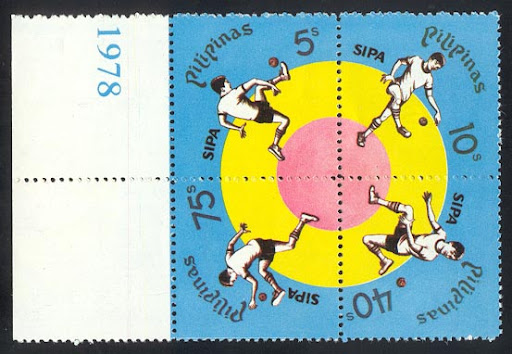

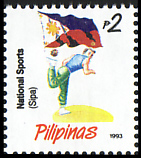



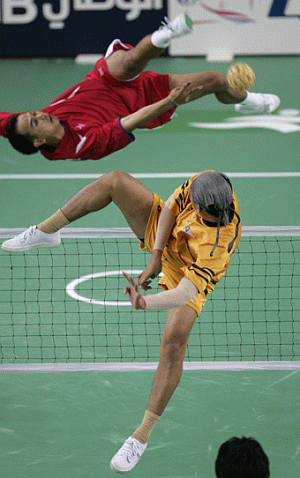











1 comments:
Post a Comment